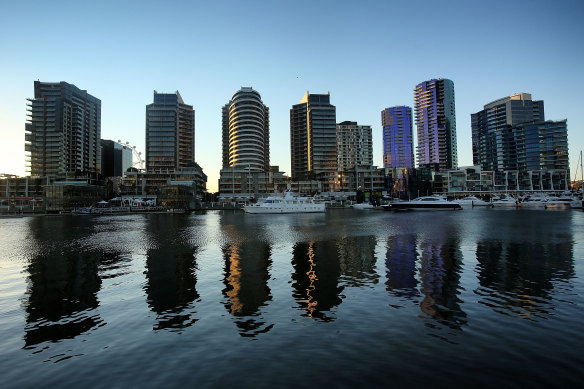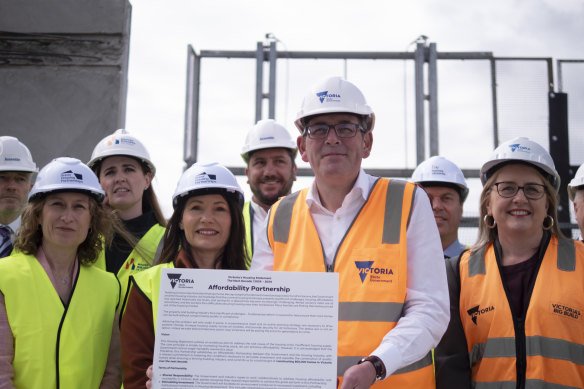By Josh Gordon, Royce Millar and Kieran Rooney
Victorian builders are now shelving more flats and townhouses than they are starting – despite being given the green light to press ahead by local councils.
During the final three months of last year, property developers and builders opted not to press ahead with 5445 approved flats or townhouses. It was the worst result for five years. At the same time, work started on just 5043 of the same types of dwellings.

Apartments in Docklands.Credit: The Age
The state government has repeatedly singled out not-in-my-backyard local councils for standing in the way of its aspiration to densify Melbourne, warning the city cannot afford to keep expanding at the fringes.
As The Age revealed this week, the government is set to enshrine housing targets in local planning schemes, and is looking at stripping councils of their planning powers if they fail to achieve their targets. The government was also considering replacing the growth areas infrastructure contributions fee on developers with a universal liveability charge across all suburbs and towns.
But figures from the Australian Bureau of Statistics suggest jittery developers are as much the cause of Victoria’s housing woes, with rising interest rates and soaring building costs clouding the economic outlook.
Over the past year, a total of 18,156 apartments and townhouses were approved but not started, compared with 20,712 that commenced.
RMIT emeritus professor of public policy David Hayward said a lack of approvals by local councils was not the main issue.
“It is developers not completing what they have already had approved,” he said. “This is further evidence that the Allan government’s decision to focus on local government planning activity as the villain is misguided.”
Labor announced its plan to introduce targets as part of its landmark housing statement in September. Since then, it has been consulting behind closed doors with property industry groups as part of a so-called affordability partnership signed alongside the housing statement.
Urban Development Institute of Australia (Victoria) chief executive Linda Allison said the institute supported the introduction of local housing targets, although she had not yet seen details. “It’s important that we know where future housing is earmarked to go,” she said.

Then-premier Daniel Andrews released his housing policy in September and signed an “affordability pledge” with representatives from the property sector.Credit: Elke Meitzel
Allison said that while the government was focused on getting more homes built in established suburbs, targets were also important for the 30 per cent of housing that would still be developed in greenfield estates on the urban fringe.
“At present, there is no commitment by the government to enable this supply, and we would welcome greater transparency on delivery against these targets,” she said. But other housing experts and commentators question the effectiveness of targets.
University of Sydney professor of planning Nicole Gurran said that while targets were useful to ensure municipalities had adequate land zoned to accommodate projected housing need, they were not “magic”.
“In Australia, since 98 to 99 per cent of all homes are built by the market, targets are just a standard way to ensure the planning system accommodates growth – the rest depends on market conditions,” she said.
Economist and housing policy specialist Cameron Murray criticised housing targets as “political theatre” and “not worth the paper they’re written on”.
He said targets seemed to have had little impact in New South Wales or London and questioned the point of introducing them in Victoria.
Murray said the current lack of housing was not due to “pesky” councils blocking apartments but to an economic climate that made building apartments unprofitable for developers.
“There is this hidden assumption that the market wants to build way more than it is. The reality is that we can’t make developers make less money,” he said.
On Tuesday, Opposition Leader John Pesutto attacked the idea of a universal liveability charge, saying it was a new tax that would be passed on to home owners and tenants.
“What our state needs is leadership in terms of infrastructure and leadership in terms of getting the costs of construction down in Victoria because it is becoming exceedingly expensive to build new homes in Victoria compared to other states,” Pesutto said.
Premier Jacinta Allan said the government was using “every lever we possibly can to build more homes across the state”.
“We need councils to also do more. It’s not good enough to put up the shutters and say we shouldn’t build any more homes here.”
The Morning Edition newsletter is our guide to the day’s most important and interesting stories, analysis and insights. Sign up here.